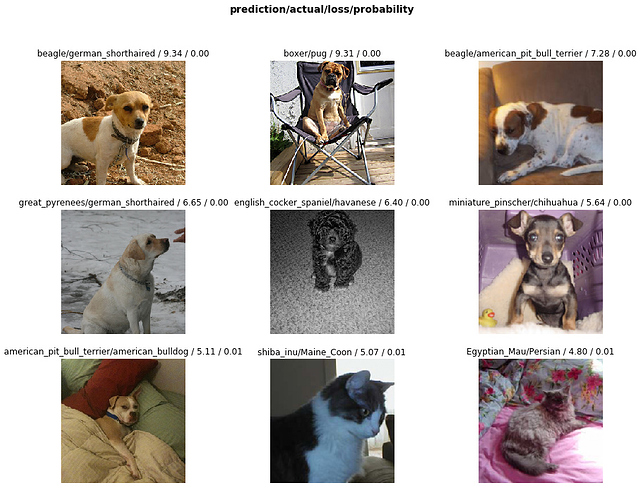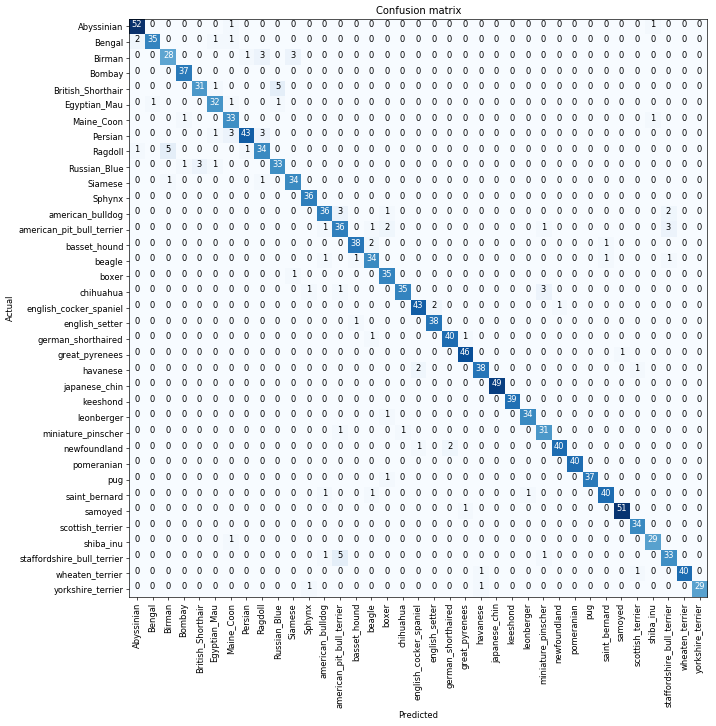One of Jeremy’s advices EN 中文 is to write all the notebooks from scratch. Maybe dictation as the following is one small step towards putting this advice into practice.
Lesson 1 - What’s your pet
the purpose of this Nb
the purpose of this Nb
In this lesson we will build our first image classifier from scratch, and see if we can achieve world-class results. Let’s dive in!
three lines of magics
three lines of magics
Every notebook starts with the following three lines; they ensure that any edits to libraries you make are reloaded here automatically, and also that any charts or images displayed are shown in this notebook.
%reload_ext autoreload
%autoreload 2
%matplotlib inline
how fastai designs import
how fastai designs import
We import all the necessary packages. We are going to work with the fastai V1 library which sits on top of Pytorch 1.0. The fastai library provides many useful functions that enable us to quickly and easily build neural networks and train our models.
import everything we need
import everything we need
from fastai.vision import *
from fastai.metrics import error_rate
how to handle out of memory problem?
how to handle out of memory problem?
If you’re using a computer with an unusually small GPU, you may get an out of memory error when running this notebook. If this happens, click Kernel->Restart, uncomment the 2nd line below to use a smaller batch size (you’ll learn all about what this means during the course), and try again.
set batch_size
set batch_size
bs = 64
# bs = 16 # uncomment this line if you run out of memory even after clicking Kernel->Restart
Looking at the data
What Pets dataset is about?
What Pets dataset is about?
We are going to use the Oxford-IIIT Pet Dataset by O. M. Parkhi et al., 2012 which features 12 cat breeds and 25 dogs breeds. Our model will need to learn to differentiate between these 37 distinct categories. According to their paper, the best accuracy they could get in 2012 was 59.21%, using a complex model that was specific to pet detection, with separate “Image”, “Head”, and “Body” models for the pet photos. Let’s see how accurate we can be using deep learning!
We are going to use the untar_data function to which we must pass a URL as an argument and which will download and extract the data.
How to get docs
How to get docs
help(untar_data)
Help on function untar_data in module fastai.datasets:
untar_data(url: str, fname: Union[pathlib.Path, str] = None, dest: Union[pathlib.Path, str] = None, data=True, force_download=False) -> pathlib.Path
Download `url` to `fname` if it doesn't exist, and un-tgz to folder `dest`.
how fastai get dataset
how fastai get dataset
path = untar_data(URLs.PETS); path
PosixPath('/home/ubuntu/.fastai/data/oxford-iiit-pet')
how to see inside a folder
how to see inside a folder
path.ls()
[PosixPath('/home/ubuntu/.fastai/data/oxford-iiit-pet/images'),
PosixPath('/home/ubuntu/.fastai/data/oxford-iiit-pet/annotations')]
how to build path to sub-folders
how to build path to sub-folders
path_anno = path/'annotations'
path_img = path/'images'
what does it mean to look at the data
what does it mean to look at the data
The first thing we do when we approach a problem is to take a look at the data. We always need to understand very well what the problem is and what the data looks like before we can figure out how to solve it. Taking a look at the data means understanding how the data directories are structured, what the labels are and what some sample images look like.
getting labels is the key of handling dataset
getting labels is the key of handling dataset
The main difference between the handling of image classification datasets is the way labels are stored. In this particular dataset, labels are stored in the filenames themselves. We will need to extract them to be able to classify the images into the correct categories. Fortunately, the fastai library has a handy function made exactly for this, ImageDataBunch.from_name_re gets the labels from the filenames using a regular expression.
turn files inside a folder into a list of path objects
turn files inside a folder into a list of path objects
fnames = get_image_files(path_img)
fnames[:5]
[PosixPath('/home/ubuntu/.fastai/data/oxford-iiit-pet/images/saint_bernard_188.jpg'),
PosixPath('/home/ubuntu/.fastai/data/oxford-iiit-pet/images/staffordshire_bull_terrier_114.jpg'),
PosixPath('/home/ubuntu/.fastai/data/oxford-iiit-pet/images/Persian_144.jpg'),
PosixPath('/home/ubuntu/.fastai/data/oxford-iiit-pet/images/Maine_Coon_268.jpg'),
PosixPath('/home/ubuntu/.fastai/data/oxford-iiit-pet/images/newfoundland_95.jpg')]
how to make sure the same validation set?
how to make sure the same validation set?
np.random.seed(2)
pat = r'/([^/]+)_\d+.jpg$'
how to create an ImageDataBunch from re
how to create an ImageDataBunch from re
data = ImageDataBunch.from_name_re(path_img,
fnames,
pat,
ds_tfms=get_transforms(),
size=224,
bs=bs
).normalize(imagenet_stats)
print out images with labels
print out images with labels
data.show_batch(rows=3, figsize=(7,6))
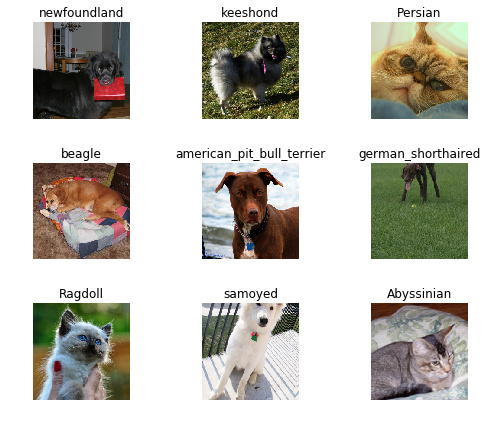
print out all classes and c
print out all classes and c
print(data.classes)
len(data.classes),data.c
['Abyssinian', 'Bengal', 'Birman', 'Bombay', 'British_Shorthair', 'Egyptian_Mau', 'Maine_Coon', 'Persian', 'Ragdoll', 'Russian_Blue', 'Siamese', 'Sphynx', 'american_bulldog', 'american_pit_bull_terrier', 'basset_hound', 'beagle', 'boxer', 'chihuahua', 'english_cocker_spaniel', 'english_setter', 'german_shorthaired', 'great_pyrenees', 'havanese', 'japanese_chin', 'keeshond', 'leonberger', 'miniature_pinscher', 'newfoundland', 'pomeranian', 'pug', 'saint_bernard', 'samoyed', 'scottish_terrier', 'shiba_inu', 'staffordshire_bull_terrier', 'wheaten_terrier', 'yorkshire_terrier']
(37, 37)
Training: resnet34
what is transfer learning like?
what is transfer learning like?
Now we will start training our model. We will use a convolutional neural network backbone and a fully connected head with a single hidden layer as a classifier. Don’t know what these things mean? Not to worry, we will dive deeper in the coming lessons. For the moment you need to know that we are building a model which will take images as input and will output the predicted probability for each of the categories (in this case, it will have 37 outputs).
We will train for 4 epochs (4 cycles through all our data).
how to create a CNN model as transfer learning
how to create a CNN model as transfer learning
learn = create_cnn(data, models.resnet34, metrics=error_rate)
how to see the structure of model
how to see the structure of model
learn.model
Sequential(
(0): Sequential(
(0): Conv2d(3, 64, kernel_size=(7, 7), stride=(2, 2), padding=(3, 3), bias=False)
(1): BatchNorm2d(64, eps=1e-05, momentum=0.1, affine=True, track_running_stats=True)
(2): ReLU(inplace)
(3): MaxPool2d(kernel_size=3, stride=2, padding=1, dilation=1, ceil_mode=False)
(4): Sequential(
(0): BasicBlock(
(conv1): Conv2d(64, 64, kernel_size=(3, 3), stride=(1, 1), padding=(1, 1), bias=False)
(bn1): BatchNorm2d(64, eps=1e-05, momentum=0.1, affine=True, track_running_stats=True)
(relu): ReLU(inplace)
(conv2): Conv2d(64, 64, kernel_size=(3, 3), stride=(1, 1), padding=(1, 1), bias=False)
(bn2): BatchNorm2d(64, eps=1e-05, momentum=0.1, affine=True, track_running_stats=True)
)
(1): BasicBlock(
(conv1): Conv2d(64, 64, kernel_size=(3, 3), stride=(1, 1), padding=(1, 1), bias=False)
(bn1): BatchNorm2d(64, eps=1e-05, momentum=0.1, affine=True, track_running_stats=True)
(relu): ReLU(inplace)
(conv2): Conv2d(64, 64, kernel_size=(3, 3), stride=(1, 1), padding=(1, 1), bias=False)
(bn2): BatchNorm2d(64, eps=1e-05, momentum=0.1, affine=True, track_running_stats=True)
)
(2): BasicBlock(
(conv1): Conv2d(64, 64, kernel_size=(3, 3), stride=(1, 1), padding=(1, 1), bias=False)
(bn1): BatchNorm2d(64, eps=1e-05, momentum=0.1, affine=True, track_running_stats=True)
(relu): ReLU(inplace)
(conv2): Conv2d(64, 64, kernel_size=(3, 3), stride=(1, 1), padding=(1, 1), bias=False)
(bn2): BatchNorm2d(64, eps=1e-05, momentum=0.1, affine=True, track_running_stats=True)
)
)
(5): Sequential(
(0): BasicBlock(
(conv1): Conv2d(64, 128, kernel_size=(3, 3), stride=(2, 2), padding=(1, 1), bias=False)
(bn1): BatchNorm2d(128, eps=1e-05, momentum=0.1, affine=True, track_running_stats=True)
(relu): ReLU(inplace)
(conv2): Conv2d(128, 128, kernel_size=(3, 3), stride=(1, 1), padding=(1, 1), bias=False)
(bn2): BatchNorm2d(128, eps=1e-05, momentum=0.1, affine=True, track_running_stats=True)
(downsample): Sequential(
(0): Conv2d(64, 128, kernel_size=(1, 1), stride=(2, 2), bias=False)
(1): BatchNorm2d(128, eps=1e-05, momentum=0.1, affine=True, track_running_stats=True)
)
)
(1): BasicBlock(
(conv1): Conv2d(128, 128, kernel_size=(3, 3), stride=(1, 1), padding=(1, 1), bias=False)
(bn1): BatchNorm2d(128, eps=1e-05, momentum=0.1, affine=True, track_running_stats=True)
(relu): ReLU(inplace)
(conv2): Conv2d(128, 128, kernel_size=(3, 3), stride=(1, 1), padding=(1, 1), bias=False)
(bn2): BatchNorm2d(128, eps=1e-05, momentum=0.1, affine=True, track_running_stats=True)
)
(2): BasicBlock(
(conv1): Conv2d(128, 128, kernel_size=(3, 3), stride=(1, 1), padding=(1, 1), bias=False)
(bn1): BatchNorm2d(128, eps=1e-05, momentum=0.1, affine=True, track_running_stats=True)
(relu): ReLU(inplace)
(conv2): Conv2d(128, 128, kernel_size=(3, 3), stride=(1, 1), padding=(1, 1), bias=False)
(bn2): BatchNorm2d(128, eps=1e-05, momentum=0.1, affine=True, track_running_stats=True)
)
(3): BasicBlock(
(conv1): Conv2d(128, 128, kernel_size=(3, 3), stride=(1, 1), padding=(1, 1), bias=False)
(bn1): BatchNorm2d(128, eps=1e-05, momentum=0.1, affine=True, track_running_stats=True)
(relu): ReLU(inplace)
(conv2): Conv2d(128, 128, kernel_size=(3, 3), stride=(1, 1), padding=(1, 1), bias=False)
(bn2): BatchNorm2d(128, eps=1e-05, momentum=0.1, affine=True, track_running_stats=True)
)
)
(6): Sequential(
(0): BasicBlock(
(conv1): Conv2d(128, 256, kernel_size=(3, 3), stride=(2, 2), padding=(1, 1), bias=False)
(bn1): BatchNorm2d(256, eps=1e-05, momentum=0.1, affine=True, track_running_stats=True)
(relu): ReLU(inplace)
(conv2): Conv2d(256, 256, kernel_size=(3, 3), stride=(1, 1), padding=(1, 1), bias=False)
(bn2): BatchNorm2d(256, eps=1e-05, momentum=0.1, affine=True, track_running_stats=True)
(downsample): Sequential(
(0): Conv2d(128, 256, kernel_size=(1, 1), stride=(2, 2), bias=False)
(1): BatchNorm2d(256, eps=1e-05, momentum=0.1, affine=True, track_running_stats=True)
)
)
(1): BasicBlock(
(conv1): Conv2d(256, 256, kernel_size=(3, 3), stride=(1, 1), padding=(1, 1), bias=False)
(bn1): BatchNorm2d(256, eps=1e-05, momentum=0.1, affine=True, track_running_stats=True)
(relu): ReLU(inplace)
(conv2): Conv2d(256, 256, kernel_size=(3, 3), stride=(1, 1), padding=(1, 1), bias=False)
(bn2): BatchNorm2d(256, eps=1e-05, momentum=0.1, affine=True, track_running_stats=True)
)
(2): BasicBlock(
(conv1): Conv2d(256, 256, kernel_size=(3, 3), stride=(1, 1), padding=(1, 1), bias=False)
(bn1): BatchNorm2d(256, eps=1e-05, momentum=0.1, affine=True, track_running_stats=True)
(relu): ReLU(inplace)
(conv2): Conv2d(256, 256, kernel_size=(3, 3), stride=(1, 1), padding=(1, 1), bias=False)
(bn2): BatchNorm2d(256, eps=1e-05, momentum=0.1, affine=True, track_running_stats=True)
)
(3): BasicBlock(
(conv1): Conv2d(256, 256, kernel_size=(3, 3), stride=(1, 1), padding=(1, 1), bias=False)
(bn1): BatchNorm2d(256, eps=1e-05, momentum=0.1, affine=True, track_running_stats=True)
(relu): ReLU(inplace)
(conv2): Conv2d(256, 256, kernel_size=(3, 3), stride=(1, 1), padding=(1, 1), bias=False)
(bn2): BatchNorm2d(256, eps=1e-05, momentum=0.1, affine=True, track_running_stats=True)
)
(4): BasicBlock(
(conv1): Conv2d(256, 256, kernel_size=(3, 3), stride=(1, 1), padding=(1, 1), bias=False)
(bn1): BatchNorm2d(256, eps=1e-05, momentum=0.1, affine=True, track_running_stats=True)
(relu): ReLU(inplace)
(conv2): Conv2d(256, 256, kernel_size=(3, 3), stride=(1, 1), padding=(1, 1), bias=False)
(bn2): BatchNorm2d(256, eps=1e-05, momentum=0.1, affine=True, track_running_stats=True)
)
(5): BasicBlock(
(conv1): Conv2d(256, 256, kernel_size=(3, 3), stride=(1, 1), padding=(1, 1), bias=False)
(bn1): BatchNorm2d(256, eps=1e-05, momentum=0.1, affine=True, track_running_stats=True)
(relu): ReLU(inplace)
(conv2): Conv2d(256, 256, kernel_size=(3, 3), stride=(1, 1), padding=(1, 1), bias=False)
(bn2): BatchNorm2d(256, eps=1e-05, momentum=0.1, affine=True, track_running_stats=True)
)
)
(7): Sequential(
(0): BasicBlock(
(conv1): Conv2d(256, 512, kernel_size=(3, 3), stride=(2, 2), padding=(1, 1), bias=False)
(bn1): BatchNorm2d(512, eps=1e-05, momentum=0.1, affine=True, track_running_stats=True)
(relu): ReLU(inplace)
(conv2): Conv2d(512, 512, kernel_size=(3, 3), stride=(1, 1), padding=(1, 1), bias=False)
(bn2): BatchNorm2d(512, eps=1e-05, momentum=0.1, affine=True, track_running_stats=True)
(downsample): Sequential(
(0): Conv2d(256, 512, kernel_size=(1, 1), stride=(2, 2), bias=False)
(1): BatchNorm2d(512, eps=1e-05, momentum=0.1, affine=True, track_running_stats=True)
)
)
(1): BasicBlock(
(conv1): Conv2d(512, 512, kernel_size=(3, 3), stride=(1, 1), padding=(1, 1), bias=False)
(bn1): BatchNorm2d(512, eps=1e-05, momentum=0.1, affine=True, track_running_stats=True)
(relu): ReLU(inplace)
(conv2): Conv2d(512, 512, kernel_size=(3, 3), stride=(1, 1), padding=(1, 1), bias=False)
(bn2): BatchNorm2d(512, eps=1e-05, momentum=0.1, affine=True, track_running_stats=True)
)
(2): BasicBlock(
(conv1): Conv2d(512, 512, kernel_size=(3, 3), stride=(1, 1), padding=(1, 1), bias=False)
(bn1): BatchNorm2d(512, eps=1e-05, momentum=0.1, affine=True, track_running_stats=True)
(relu): ReLU(inplace)
(conv2): Conv2d(512, 512, kernel_size=(3, 3), stride=(1, 1), padding=(1, 1), bias=False)
(bn2): BatchNorm2d(512, eps=1e-05, momentum=0.1, affine=True, track_running_stats=True)
)
)
)
(1): Sequential(
(0): AdaptiveConcatPool2d(
(ap): AdaptiveAvgPool2d(output_size=1)
(mp): AdaptiveMaxPool2d(output_size=1)
)
(1): Flatten()
(2): BatchNorm1d(1024, eps=1e-05, momentum=0.1, affine=True, track_running_stats=True)
(3): Dropout(p=0.25)
(4): Linear(in_features=1024, out_features=512, bias=True)
(5): ReLU(inplace)
(6): BatchNorm1d(512, eps=1e-05, momentum=0.1, affine=True, track_running_stats=True)
(7): Dropout(p=0.5)
(8): Linear(in_features=512, out_features=37, bias=True)
)
)
how to fit the model with the best default setting
how to fit the model with the best default setting
learn.fit_one_cycle(4)
Total time: 01:46
| epoch | train_loss | valid_loss | error_rate |
|---|---|---|---|
| 1 | 1.409939 | 0.357608 | 0.102165 |
| 2 | 0.539408 | 0.242496 | 0.073072 |
| 3 | 0.340212 | 0.221338 | 0.066306 |
| 4 | 0.261859 | 0.216619 | 0.071042 |
how to save a model
how to save a model
learn.save('stage-1')
Results
how do we know our model is working correctly or reasonably or not?
how do we know our model is working correctly or reasonably or not?
Let’s see what results we have got.
We will first see which were the categories that the model most confused with one another. We will try to see if what the model predicted was reasonable or not. In this case the mistakes look reasonable (none of the mistakes seems obviously naive). This is an indicator that our classifier is working correctly.
what can confusion matrix tell us?
what can confusion matrix tell us?
Furthermore, when we plot the confusion matrix, we can see that the distribution is heavily skewed: the model makes the same mistakes over and over again but it rarely confuses other categories. This suggests that it just finds it difficult to distinguish some specific categories between each other; this is normal behaviour.
how to access the idx and losses of the images with the top losses
how to access the idx and losses of the images with the top losses
interp = ClassificationInterpretation.from_learner(learn)
losses,idxs = interp.top_losses()
len(data.valid_ds)==len(losses)==len(idxs)
True
how to plot the top loss images
how to plot the top loss images
interp.plot_top_losses(9, figsize=(15,11))
how to print out docs nicely
how to print out docs nicely
doc(interp.plot_top_losses)
how to plot confusion matrix
how to plot confusion matrix
interp.plot_confusion_matrix(figsize=(12,12), dpi=60)
how to print out the most confused categories and count errors
how to print out the most confused categories and count errors
interp.most_confused(min_val=2)
[('British_Shorthair', 'Russian_Blue', 5),
('Ragdoll', 'Birman', 5),
('staffordshire_bull_terrier', 'american_pit_bull_terrier', 5),
('Birman', 'Ragdoll', 3),
('Birman', 'Siamese', 3),
('Persian', 'Maine_Coon', 3),
('Persian', 'Ragdoll', 3),
('Russian_Blue', 'British_Shorthair', 3),
('american_bulldog', 'american_pit_bull_terrier', 3),
('american_pit_bull_terrier', 'staffordshire_bull_terrier', 3),
('chihuahua', 'miniature_pinscher', 3)]
Unfreezing, fine-tuning, and learning rates
when to unfreeze the model?
when to unfreeze the model?
Since our model is working as we expect it to, we will unfreeze our model and train some more.
how to unfreeze the model?
how to unfreeze the model?
learn.unfreeze()
how to fit for one epoch
how to fit for one epoch
learn.fit_one_cycle(1)
Total time: 00:26
| epoch | train_loss | valid_loss | error_rate |
|---|---|---|---|
| 1 | 0.558166 | 0.314579 | 0.101489 |
how to save the model
how to save the model
learn.load('stage-1');
how to explore lr within a range for lower loss?
how to explore lr within a range for lower loss?
learn.lr_find()
LR Finder is complete, type {learner_name}.recorder.plot() to see the graph.
how to plot the loss-lr graph and read the best range?
how to plot the loss-lr graph and read the best range?
learn.recorder.plot()

how to unfreeze model and fit with a specific range of lr with epochs
how to unfreeze model and fit with a specific range of lr with epochs
learn.unfreeze()
learn.fit_one_cycle(2, max_lr=slice(1e-6,1e-4))
Total time: 00:53
| epoch | train_loss | valid_loss | error_rate |
|---|---|---|---|
| 1 | 0.242544 | 0.208489 | 0.067659 |
| 2 | 0.206940 | 0.204482 | 0.062246 |
That’s a pretty accurate model!
Training: resnet50
what is the difference between resnet34 and resnet50
what is the difference between resnet34 and resnet50
Now we will train in the same way as before but with one caveat: instead of using resnet34 as our backbone we will use resnet50 (resnet34 is a 34 layer residual network while resnet50 has 50 layers. It will be explained later in the course and you can learn the details in the resnet paper).
why use larger model and image to train with smaller batch size?
why use larger model and image to train with smaller batch size?
Basically, resnet50 usually performs better because it is a deeper network with more parameters. Let’s see if we can achieve a higher performance here. To help it along, let’s us use larger images too, since that way the network can see more detail. We reduce the batch size a bit since otherwise this larger network will require more GPU memory.
how to create an ImageDatabunch with re and setting image size and batch size?
how to create an ImageDatabunch with re and setting image size and batch size?
data = ImageDataBunch.from_name_re(path_img,
fnames,
pat,
ds_tfms=get_transforms(),
size=299,
bs=bs//2).normalize(imagenet_stats)
how to create an CNN model with this data?
how to create an CNN model with this data?
learn = create_cnn(data, models.resnet50, metrics=error_rate)
find and plot the loss-lr relation
find and plot the loss-lr relation
learn.lr_find()
learn.recorder.plot()
LR Finder complete, type {learner_name}.recorder.plot() to see the graph.
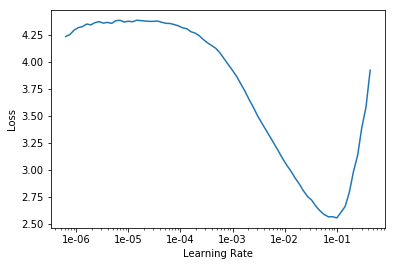
how to fit the model 8 epochs
how to fit the model 8 epochs
learn.fit_one_cycle(8)
Total time: 06:59
epoch train_loss valid_loss error_rate
1 0.548006 0.268912 0.076455 (00:57)
2 0.365533 0.193667 0.064953 (00:51)
3 0.336032 0.211020 0.073072 (00:51)
4 0.263173 0.212025 0.060893 (00:51)
5 0.217016 0.183195 0.063599 (00:51)
6 0.161002 0.167274 0.048038 (00:51)
7 0.086668 0.143490 0.044655 (00:51)
8 0.082288 0.154927 0.046008 (00:51)
how to save the model with a different name
how to save the model with a different name
learn.save('stage-1-50')
It’s astonishing that it’s possible to recognize pet breeds so accurately! Let’s see if full fine-tuning helps:
how to unfreeze and fit with a specific range for 3 epochs
how to unfreeze and fit with a specific range for 3 epochs
learn.unfreeze()
learn.fit_one_cycle(3, max_lr=slice(1e-6,1e-4))
Total time: 03:27
epoch train_loss valid_loss error_rate
1 0.097319 0.155017 0.048038 (01:10)
2 0.074885 0.144853 0.044655 (01:08)
3 0.063509 0.144917 0.043978 (01:08)
how to go back to previous model
how to go back to previous model
learn.load('stage-1-50');
how to get classification model interpretor
how to get classification model interpretor
interp = ClassificationInterpretation.from_learner(learn)
how to print out the most confused categories with minimum count
how to print out the most confused categories with minimum count
interp.most_confused(min_val=2)
[('american_pit_bull_terrier', 'staffordshire_bull_terrier', 6),
('Bengal', 'Egyptian_Mau', 5),
('Bengal', 'Abyssinian', 4),
('boxer', 'american_bulldog', 4),
('Ragdoll', 'Birman', 4),
('Egyptian_Mau', 'Bengal', 3)]
Other data formats
how to get MNIST_SAMPLE dataset
how to get MNIST_SAMPLE dataset
path = untar_data(URLs.MNIST_SAMPLE); path
PosixPath('/home/ubuntu/course-v3/nbs/dl1/data/mnist_sample')
how to set flip false for transformation
how to set flip false for transformation
tfms = get_transforms(do_flip=False)
how to create ImageDataBunch from folders
how to create ImageDataBunch from folders
data = ImageDataBunch.from_folder(path, ds_tfms=tfms, size=26)
how to print out image examples from a batch
how to print out image examples from a batch
data.show_batch(rows=3, figsize=(5,5))
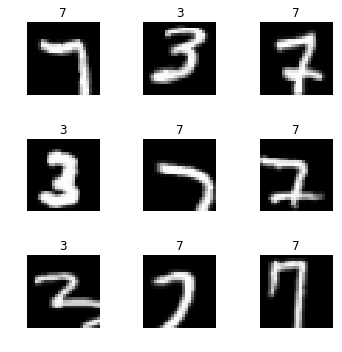
how to create a cnn with resnet18 and accuracy as metrics
how to create a cnn with resnet18 and accuracy as metrics
learn = create_cnn(data, models.resnet18, metrics=accuracy)
how to fit 2 epocs
how to fit 2 epocs
learn.fit(2)
Total time: 00:23
epoch train_loss valid_loss accuracy
1 0.116117 0.029745 0.991168 (00:12)
2 0.056860 0.015974 0.994603 (00:10)
how to read a csv with pd
how to read a csv with pd
df = pd.read_csv(path/'labels.csv')
how to read first 5 lines
how to read first 5 lines
df.head()
.dataframe tbody tr th {
vertical-align: top;
}
.dataframe thead th {
text-align: right;
}
| name | label | |
|---|---|---|
| 0 | train/3/7463.png | 0 |
| 1 | train/3/21102.png | 0 |
| 2 | train/3/31559.png | 0 |
| 3 | train/3/46882.png | 0 |
| 4 | train/3/26209.png | 0 |
how to create ImageDataBunch with csv
how to create ImageDataBunch with csv
data = ImageDataBunch.from_csv(path, ds_tfms=tfms, size=28)
how to print out images from a batch and classes
how to print out images from a batch and classes
data.show_batch(rows=3, figsize=(5,5))
data.classes
[0, 1]

how to create ImageDataBunch from df
how to create ImageDataBunch from df
data = ImageDataBunch.from_df(path, df, ds_tfms=tfms, size=24)
data.classes
[0, 1]
how to create file path object into a list from df
how to create file path object into a list from df
fn_paths = [path/name for name in df['name']]; fn_paths[:2]
[PosixPath('/home/ubuntu/course-v3/nbs/dl1/data/mnist_sample/train/3/7463.png'),
PosixPath('/home/ubuntu/course-v3/nbs/dl1/data/mnist_sample/train/3/21102.png')]
how to create ImageDataBunch from re
how to create ImageDataBunch from re
pat = r"/(\d)/\d+\.png$"
data = ImageDataBunch.from_name_re(path, fn_paths, pat=pat, ds_tfms=tfms, size=24)
data.classes
['3', '7']
how to create ImageDataBunch from name function with file path list
how to create ImageDataBunch from name function with file path list
data = ImageDataBunch.from_name_func(path, fn_paths, ds_tfms=tfms, size=24,
label_func = lambda x: '3' if '/3/' in str(x) else '7')
data.classes
['3', '7']
how to create a list of labels from list of file path
how to create a list of labels from list of file path
labels = [('3' if '/3/' in str(x) else '7') for x in fn_paths]
labels[:5]
['3', '3', '3', '3', '3']
how to create an ImageDataBunch from list
how to create an ImageDataBunch from list
data = ImageDataBunch.from_lists(path, fn_paths, labels=labels, ds_tfms=tfms, size=24)
data.classes
['3', '7']
